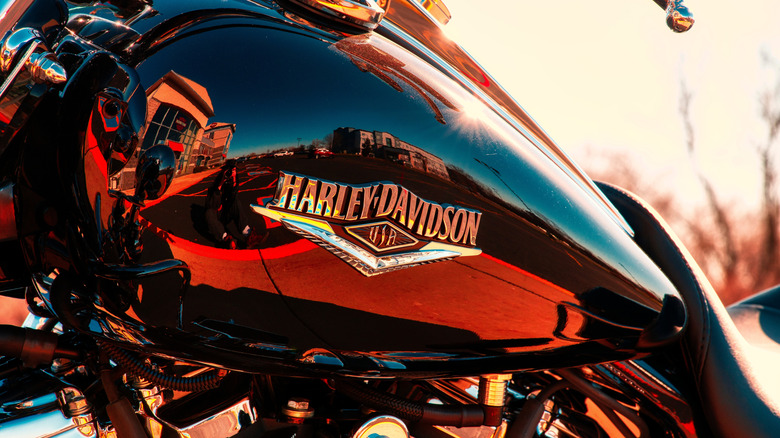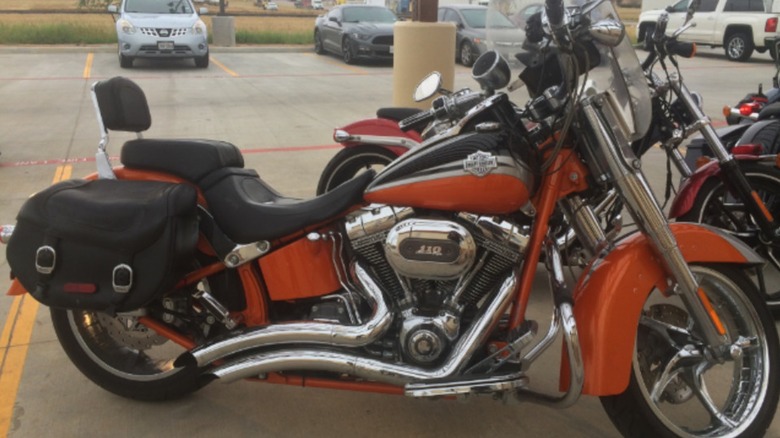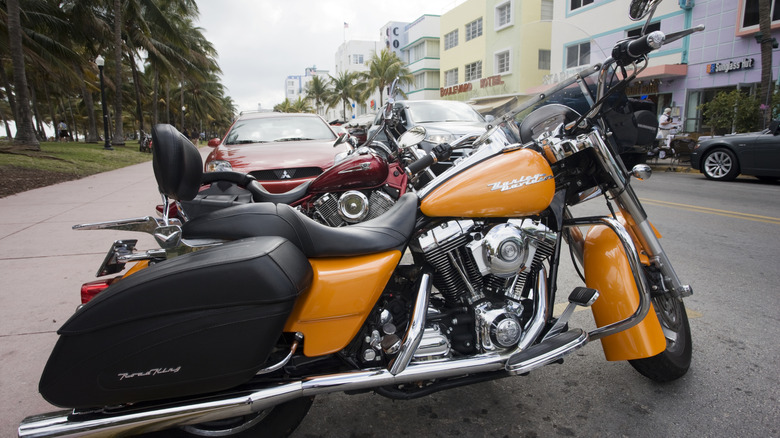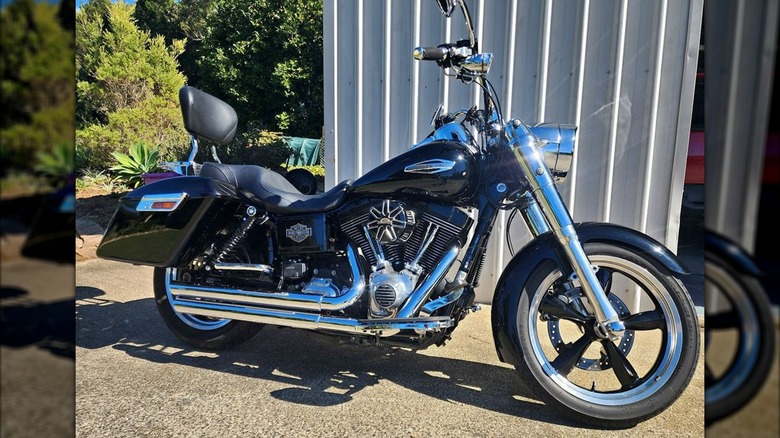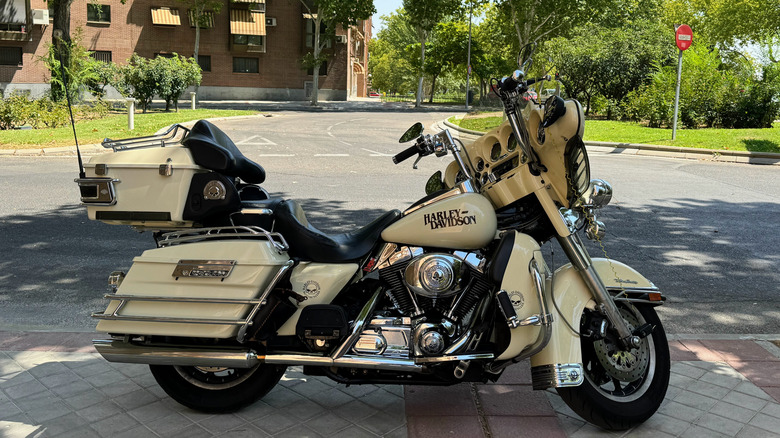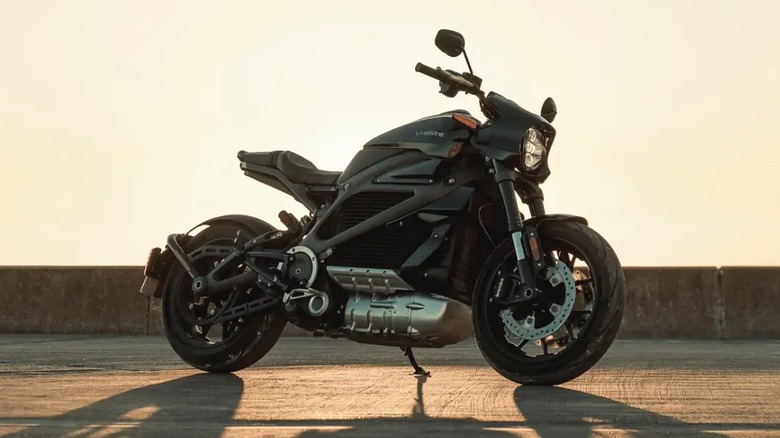10 Harley-Davidson Motorcycles That Are Dirt Cheap To Maintain
The Harley-Davidson brand traces its roots back to 1903, when Harley and Davidson (William and Arthur) teamed up to create a new motorcycle in their friend's Milwaukee shed. The pair had been close friends for a decade, sharing in a love of automotive design and mechanical exploration. The venture's first motorcycle (the Model 1) was the product of two years of engine design, and lacked the ability to successfully navigate hilly terrain, but the seed of an idea had successfully taken root, and plenty of extraordinary bikes would spring forth from the pair's collective imagination in the years that followed.
Some of the best Harley-Davidsons ever made include the WWII-era WLA Liberator, the iconic Fat Boy, and of course, the Sportster. These are classics for a reason, and riders love showing off their dutifully cared for pieces of automotive history when hitting the town. But that brings us to another aspect of motorcycle ownership: upkeep. An icon is only truly iconic if it's still a serviceable machine, otherwise your beautiful bike will inevitably be relegated to a corner of the garage. While plenty of Harley owners will swear by their trusty steed, these 10 Harley-Davidsons (in no particular order) have shown themselves to be seriously durable options that can take tons of punishment and keep on chugging.
Sportster
Harley-Davidson first unveiled the Sportster in 1957, and it has become the brand's all-time best selling model. It's the most popular Harley and a true icon in a catalog that spans a tremendous range of styles, power options, and riding types. The Sporters stands tall, setting a speed record in 1970 at a truly ridiculous 265.49 mph and exuding classical athletic aesthetics that Harley-Davidsons are all about.
Sportsters have frequently found their way onto motorcycle roundups focused on affordability. Among Harleys, the Sportster has routinely been among the most financially friendly for riders looking to replace an aging steed or upgrade one they've grown out of. The Modern Sportster S ramps the price up a bit ($16,399 for a 2023 model), it's certainly not lacking in power and flair with redesigned features across the field. Sporters were shipped in gigantic number throughout their history, with more than 50,000 produced every year between 2012 and 2017. This makes for an abundance of spare parts available on the secondary market for all manner of model years. With its continued favorability through the years and a legendary pedigree, riders are still looking to the Sportster and its newer iterations for motorcycling inspiration. Sportsters are durable all-purpose bikes that simply get the job done and look great while they're at it.
Super Glide
Initially hitting the market as the FX Super Glide in 1971, the Super Glide featured components of the Sportster in the front end and Electra Glide in the rear, birthing a new era of customized bikes coming to the market fully realized. The bike was designed by Willie G. Davidson, the grandson of company co-founder William A. Davidson (brother of Arthur). The 1971 release featured a V-Twin engine with a displacement measured at 1,207cc. It was an air cooled design that deployed 65 horsepower with the help of a four-speed transmission. While the frame and aesthetic choices might have seemed radical, the machine benefitted from Harley-Davidson's long history of performance engineering and featured easy to maintain components (a four-speed bringing fewer moving parts into the equation than a six, for instance). The engine also offered riders 70 lb-ft of max torque at 4,000 rpm.
This was a heavy bike, though, with a wet weight figure of 749.6 pounds. Reviewing the service manuals for FX Super Glides through to 1978, Harley-Davidson recommended standard service checks like brake inspections and oil checks. A standard carburetors inspection and spark plug cleaning is also recommended at the first 500 mile check. After that, standard inspections should be done at 1,000, 2,000, and 5,000 intervals. Harley-Davidson suggests a spark plug replacement every 5,000 miles, for instance, placing the Super Glide in line with other bikes in its orbit. Standard oiling tasks should be done every 1,000 miles, as well.
CVO Softail Convertible
The CVO moniker is a crowning feature in the Harley-Davidson catalog. "Custom Vehicle Operations" Harleys are enhanced models with all the bells and whistles. They're some of the most dependable and, of course, fun to ride Harleys out there. A CVO Harley has been fine-tuned to the needs of riders, creating a supremely premium riding experience. Custom rides often feature reduced maintenance costs because they've been designed for enhanced performance. This typically cuts down on the amount of maintenance necessary to keep the bike on the road.
Making things even more valuable to riders hoping to keep their bike in great condition without extreme financial demands, the CVO Softail Convertible is one of the cheaper options in terms of standard maintenance, even without venturing into the high performance CVO enhancements. Softails generally come with some of the lowest prices among Harley options, great news for value-hungry riders. The CVO Softail Convertible debuted in 2010, and provides a meticulously crafted experience. The seat is positioned at a low height of 26.2 inches and creates a very comfortable riding position. The engine hums, delivering 79.5 hp at 4,750 rpm and a ridiculously low 2,750 rpm figure delivering its max torque output of 97.2 lb-ft.
Road King
The Road King is consistently named by owners as a Harley-Davidson that's easy to maintain, incredibly fun to ride, and offers solid consistency. In one Reddit thread, a questioner asks what the best all purpose Harley is, specifically looking for one that's easy to maintain. The Road King is the most often name dropped bike, with plenty of respondents putting their experiences and feelings forward with blunt honesty. The Road King (2009 model) service manual backs these claims up. Every 1,000 miles the manual calls for engine oil changes, and notes routine maintenance requirements for all other components.
The FLHR Road King is another long-standing tradition in the Harley-Davidson lineup. The bike is a massive tourer with a wet weight of 812 pounds and powered forward via a 1,584cc V-Twin featuring air cooling (a feature that reduces maintenance complexity and cost in comparison to liquid cooling systems). The engine on a 2022 Road King produces 110 lb-ft of torque at a rock bottom 3,000 rpm figure and outputs an estimated 92.5 hp. The bike features a six-speed transmission. It's got attitude and style oozing from the bike's historic vibes. The Road King indeed takes its inspiration from early stylizations of the Harley-Davidson touring bikes, making it a favorite among riders for many reasons, not just its immense durability.
Dyna Switchback
The Dyna lineup came into the Harley-Davidson stable in 1991 and remained a cornerstone of dynamic Harley innovation (the name itself alludes to a mindset of "dynamic" excellence) until 2017. Dyna models that excelled include the Dyna Low Rider and Street Bob, but the Dyna Switchback stands above the rest. NHTSA reports very few recall notices across the entirety of the Dyna line (14 in total across its 26 year production history), but features zero complaints, investigations, or recalls for the Dyna Switchback in particular. This signals a well built bike that was crafted meticulously and carefully, providing riders with a value-forward riding experience that wasn't just pleasant, but also featured massive reliability and a true longevity in the vehicle.
The switchback is a much-loved cruiser that mashes together lightweight sensibilities with heavier performance standards. The bike delivers a dry weight of 696 pounds and positions the seat at an approachable and somewhat low 27.4 inches. Maintenance on the bike clocks in at a relatively inexpensive figure (under $500), and riders often refer to this workhorse as the "Road Queen," measuring up as a smaller yet equally worthy compatriot to Harley-Davidson's venerated Road King. The bike is powered by a 1,690cc Twin-Cam 103 engine that produces 98.8 lb-ft of torque at 3,500 rpm and 75 hp. A potent and versatile steed, indeed.
Electra Glide
The Electra Glide is a tremendous tourer. The bike features all the bells and whistles, from a color LCD screen to perfectly thought-out seat dimensions and cushioning (both for the driver and an additional rider). The Electra Glide came as the innovative next generation of previous "Glide" models like the Hydra Glide and Duo Glide. These are all part of the same FL model family, and when the bike gained an electric starter in 1965 it also earned a new moniker to reflect the feature.Tourers in the Harley stable have always seen the best of the brand's innovation and new introductions before others.
The Electra Glide has successive generations of new enhancements and improvements under its belt. Most impressively, however, alongside all these new introductions, the Electra Glide hasn't been subjected to nearly as many recalls as some of its competitors (11 total in all its years on the highways, according to NHTSA data). The result is a classic tourer that routinely sees improvements, and doesn't suffer from buggy rollouts. The bike isn't overburdened with technological features — even in the modern varieties — giving riders exactly what they want without extra things to worry about when it comes time to service the motorcycle.
Low Rider
Introduced in 1977 as a new cruiser option, the Low Rider immediately turned heads and excited riders. It was an instant best-seller the year it released, and droves of riders in years since have flocked to its successive formats. Part of what makes Low Riders easy to maintain is the long history of production and sustained popularity, which makes parts available in abundance across model years. However, that's not the only factor to consider. As a cruiser that's stuck to its classic DNA in faithful reinterpretations throughout the years, it hasn't suffered from over-engineering introducing new problems to the bike's foundation. This has resulted in just a single recall instance, in which the 2001 Dyna Low Rider's stand leg required attention.
The original Low Rider (FXS Low Rider) was powered by a 1,207cc V-Twin that put out 58 hp and paired up with a four-speed transmission. Weighing 623 pounds, the Low Rider offered both kickstart capability for a classic touch while also featuring an electric starter to help on cold days. The bike remains a favorite today. From 2017 to the present Harley-Davidson has featured a Low Rider in its stable with a 1,690cc V-Twin (featuring air cooling) that retains the old school charm, and of course, the Low Rider's classic rumbling engine characteristics. Modern Low Riders produce 93 lb-ft of torque at 3,250 rpm, providing roaring engine performance and a great experience.
Fat Boy
A motorcycle that needs little introduction after Arnold Schwarzenegger's iconic use of it in "Terminator 2: Judgement Day," the famous Fat Boy has been a modern classic in Harley-Davidson's catalog from virtually the beginning of its existence. Willie G. Davidson and Louie Netz were seeking to create something distinct and instantly special when they began toying around with what would become the Fat Boy in the late 1980s. By 1990 it was in production, and Schwarzenegger's legendary visual would cement the bike's status a year later.
A 1,340cc air cooled V-Twin powered this new entrant. It produced 67 hp and 72 lb-ft of torque at a ridiculous figure of just 2,350 rpm. The bike maxed out at a speed of 112 mph. Today, the Fat Boy features an 1,868cc Milwaukee-Eight 114 engine that produces 94 hp and 84.8 lb-ft of torque at 3,250 rpm. Because of its mythic status, the Fat Boy has plenty of production examples, allowing riders to find spares quite easily. Moreover, it's built from the bare bones of a Softail tourer, making for a low-maintenance option among a stable of reliable Harleys.
Livewire One
A different approach entirely, the Livewire One is an electric motorcycle that departs entirely from Harley-Davidson's historic genes. The EV game is becoming far more competitive, and improves on a yearly basis. There are a huge range of electric car brands, and the growing number of electric motorcycle brands is showing similar levels of adoption across the automaker space. In partnership with LiveWire, Harley-Davidson constructed the powertrain found in the bike.
The Livewire One produces 100 hp and 86 lb-ft of torque, rocketing the bike forward with ease and immense power. The frame is a cast aluminum construction to provide lightweight maneuverability. Charging is lightning fast, too, providing a full battery in just 60 minutes when using a public fast charger network. The bike offers a max range estimated at 146 miles while reaching a top speed of 110 mph and doing 0-60 in 3 seconds flat. Performance metrics are the only thing to keep in mind. Electric vehicles generally experience lower maintenance costs because they feature far fewer moving parts. In an electric motorcycle, the same basic principles should apply, creating an immaculate driving experience without introducing the hassle of frequent or expensive maintenance needs that might otherwise accompany a high performance sport bike powered by a traditional engine.
CVO Tri Glide
The Harley-Davidson Tri Glide features two wheels in the back instead of a single one, which virtually eliminates some aspects of the experience that can be problematic in terms of maintenance and repair costs. For one thing, laying down a motorcycle happens on occasion and plenty of riders will have experienced the phenomenon to protect themselves and their vehicle from even more hazardous outcomes. This can severely damage the sides of a motorcycle, though. A trike can't be laid down on its side, and drives a bit more like an open air car in some regards. This adds another important point to the conversation. Cornering isn't the same on a Tri Glide, and you're not likely to scratch up lower portions of the motorcycle as a result through typical driving.
Combined with the fact that the Tri Glide is a tourer through and through, riders quickly arrive at a bike that's overwhelmingly characterized by a no-fuss approach. Among Tri Glides, however, one stands out above the pack. The CVO Tri Glide is powered by Harley's menacing Milwaukee-Eight 117 engine (measured at a 1,923cc displacement) that produces 125 lb-ft of torque at just 3,750 rpm. Adding a six-speed transmission and air cooling into the mix, the custom Harley-Davidson features a range of specifications that make for a fantastic ride with low-maintenance chops that will make any rider excited to get out on the road.
